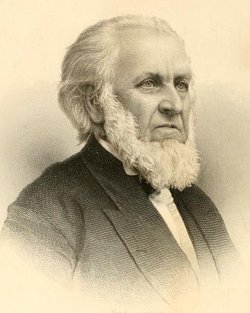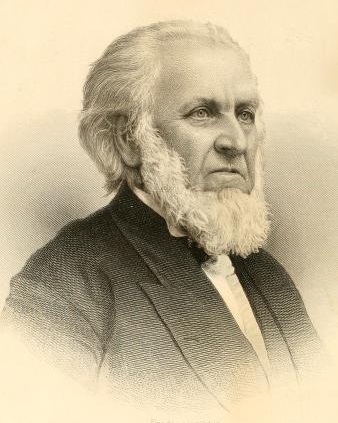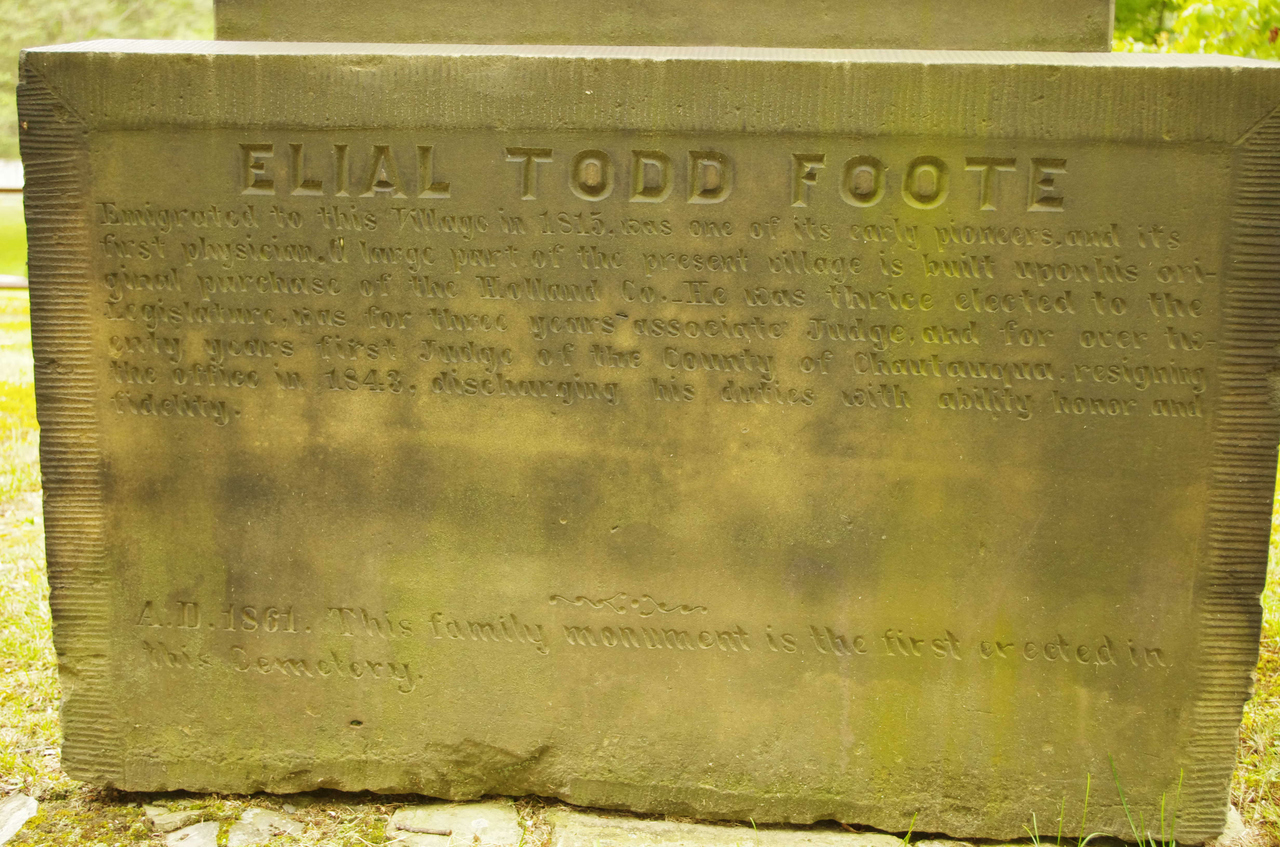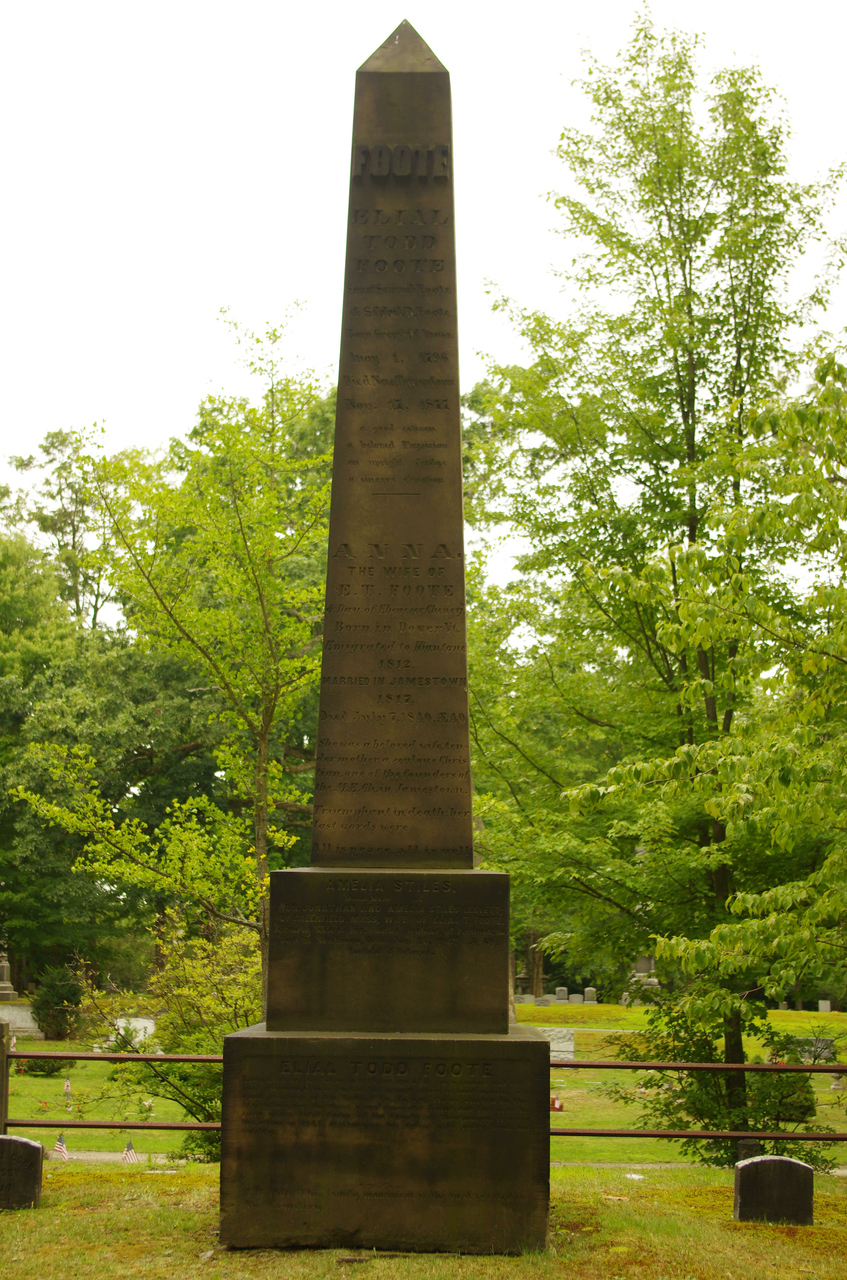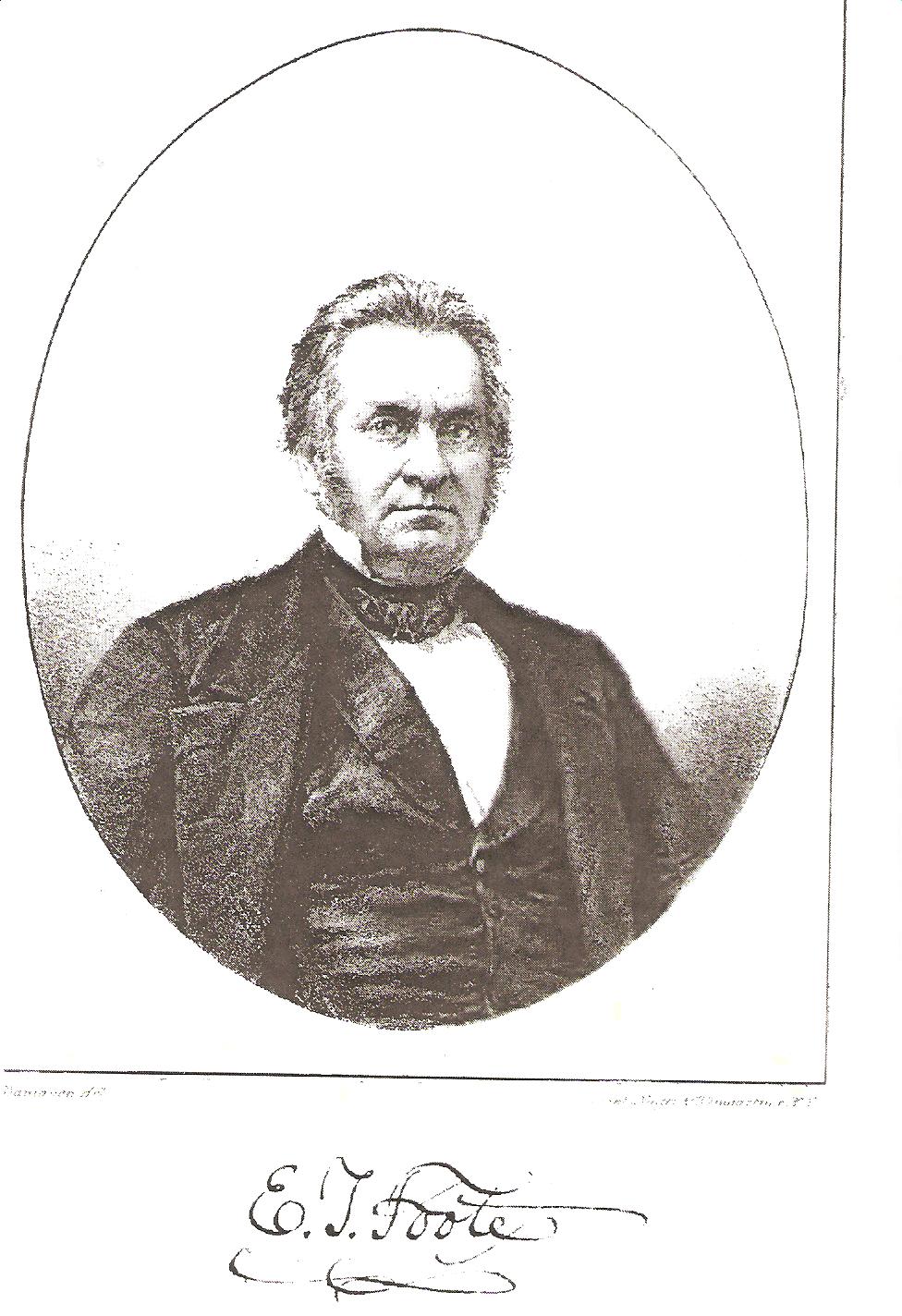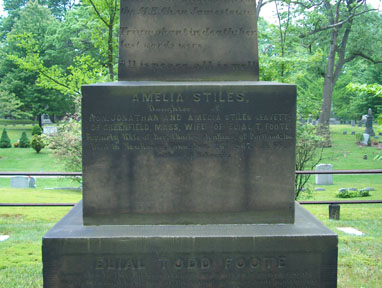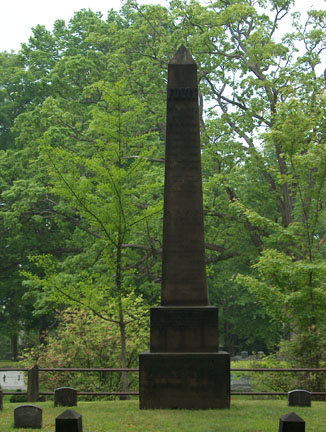Elial Todd Foote, born in Gill, Mass., May 1, 1796. Two years after his parents removed to Sherburne, NY, where he spent his boyhood. He was educated in the common school and under the tuition of Rev. W. M. Adams, and at Oxford Academy. He studied medicine at Sherburne with Dr. Guthrie and attended medical lectures in New York in 1814 and 1815. He was licensed by the Chenango County Medical Society, and later received the degree of M.D. He settled in Jamestown, Chautauqua Co., N.Y., in 1815, and was its first settled physician. He soon had an extensive practice, but the hardships and exposure incidental to practice in a new country let to attacks of asthma, and after a few years he gave up active practice, and turned his attention to business of a public nature.
In 1819, at the age of 23, he was elected to the Legislature, representing the counties of Chautauqua, Cattaraugus and Niagara. The county of Niagara then included what is now Erie County and Buffalo. During this session (1819-20) he was on the Canal Committee, an important one, for the State was then building the Erie Canal. In 1826 he was again elected to the Legislature, and again in 1827. In 1822 he purchased from the Holland Land Company a reserved tract of land, on which is now built a large part of the city of Jamestown. This, with it valuable water power, was speedily improved, and the growth of the new village greatly promoted. Jamestown now (1907) has 30,000 inhabitants. He was active in public improvements, aaiding them liberally by his means and influence. Four of the churches were built upon land donated by him for the purpose.
In 1831, the nearest bank being at Buffalo, 90 miles distant, he secured the charter for the Chautauqua County Bank, resigning his position as director of the United States branch at Buffalo to accept the presidency of the new bank, which he resigned in 1835. He was one of the fifteen who met in 1829 to organize the Chautauqua County Temperance Society, of which he was for several years the president. He was for many years the President of the Chautauqua County Bible Society, a life member of all the prominent religious and benevolent societies, in which he took a lively interest and to which he gave liberally. In 1818 he was appointed Associate Judge of the Court of Common Pleas, which office he held for five years until 1823, when he was appointed first judge of the County of Chautauqua, which office he continued to hold under reappointment by various governors every five years for 20 years. On his retirement, in 1843, the grand jury and the bar, without respect to party, and associate judges, joined unanimously in passing resolutions, bearing high testimony to the ability, fidelity, and ipartiality with which he had for so long discharged the honorable duties of his office, and expressive of their confidence and esteem. About this time (1843) he became strongly enlisted in the anti-slavery cause, and supported the Liberty ticket in 1844. He removed to New Haven, Ct., in 1845, where he resumed the practice of medicine, and ws in active practice there for some 20 years.
He was fond of historical research and collected a large amount of historical matter concerning the early history of Chautauqua, which formed the basis of the valuable history of that county, written by Mr. A. W. Young.
In 1827 he was elected a member of the Medical Society of the State of New York. He was also a membr of the Massachusetts, Connecticut and Rhode Island State Medical Societies. In 1827 he was elected an honorary member of the New York Historical Society. He was a corresponding member of the Buffalo Historical Society and of the Albany Lyceum of Natural History and the New England Genealogical and Historical Society. He was on of the founders and for many years, until his death, a directory of the New Haven Colony Historical Society.
Judge Foote m. at Jamestown, N.Y., Dec. 31, 1817, Anna Cheney, a native of Dover, Vt., and a daughter of Ebenezer Cheney, a Revolutionary soldier. His wife died July 7, 1840, and he married for his second wife, Amelia Stiles Leavitt, widow of Rev. Charles Jenkins, of Greefield, Mass., in 1841. She died at New Haven in 1867. He was again married in 1869, to Miss Emily Stockbridge, widow of S. W. Allis.
At the close of this biography of Judge Foote, it is fitting herre to make some suitable acknowledgment for the great services which he rendered in his researches, and by his published and unpublished reminiscences concerning Sherburne. In fact, it is but simple justice to say, that no other person has done more than he did to preserve the records of all that is of value and interest in the early history of this place. The writer has already appropriated much from the treasure trove of his historical collections, while much of value still remains. In a letter which had incidentally come to the hand of the writer, Judge Foote says: "I am disposed to have a sketch of West Hill Society and neighborhood published. In this way the efforts and settlement there of Major Dixon, our father, Judge Lynde, and others, will be preserved for future generations." How much, almost unconsciously, he was then contributing to that result, by inciting other to such labors! Judge Foote was a prominent member of the Masonic fraternity, and did not withdraaw from that organization even under ther great stress of the Anti-Masonic excitement of 1826-31, and was for several years Master of Mt. Moriah Lodge, at Jamestown. His early political association were with the Loco Focos, or Democrats, but his later affiliations are well shown in an incident related by Judge Stephen Holden, of Sherburne, who was at the time a student at Yale College. He says, in a communication published in "The Sherburne News" of Sept. 7, 1889: "Early in 1856 I attended a meeting at New Haven, Ct., helf to organize the Republican party for the presidential campaign. Dr. Elial T. Foote was on of the speakers, and added greatly to the enthusiasm of the meeting. The charge was then made that the then leaders of the Democrats were preaching a new doctrine on the question of slavery in the Territories. Dr. Foote, to vindicate his right to say what the original Democratic doctrine was, against the new lights in the party, among ohter things, said that he was a Democrat when they 'were mewling and uking in their nurses' arms!'" He was a man of noble presence, and, as Judge Holden says, "He was a fine looking man, of large frame and a rather broad face." He was nearly six feet in height, very dark hair, blue eyes, a fine face and head, and a frank, kindly way which made him very popular. In the spring of 1820, while yet in the Legislature, he was nominated unanimously by the district convention of the Western District of the State, as candidate for the State Senate. The nomination was a surprise to him, and he was strongly urged by influential members of the party to accept the same, but he felt constrained for personal and professional reasone to decline. Another candidate was presented and elected by a large majority.
Hon. Elial Todd Foote d. at New Haven, Ct., Nov. 17, 1877, in his 82nd year, and his remains were taken at his request to Jamestown for interment, among the friends to whom he was so strongly attached.
Elial Todd Foote, born in Gill, Mass., May 1, 1796. Two years after his parents removed to Sherburne, NY, where he spent his boyhood. He was educated in the common school and under the tuition of Rev. W. M. Adams, and at Oxford Academy. He studied medicine at Sherburne with Dr. Guthrie and attended medical lectures in New York in 1814 and 1815. He was licensed by the Chenango County Medical Society, and later received the degree of M.D. He settled in Jamestown, Chautauqua Co., N.Y., in 1815, and was its first settled physician. He soon had an extensive practice, but the hardships and exposure incidental to practice in a new country let to attacks of asthma, and after a few years he gave up active practice, and turned his attention to business of a public nature.
In 1819, at the age of 23, he was elected to the Legislature, representing the counties of Chautauqua, Cattaraugus and Niagara. The county of Niagara then included what is now Erie County and Buffalo. During this session (1819-20) he was on the Canal Committee, an important one, for the State was then building the Erie Canal. In 1826 he was again elected to the Legislature, and again in 1827. In 1822 he purchased from the Holland Land Company a reserved tract of land, on which is now built a large part of the city of Jamestown. This, with it valuable water power, was speedily improved, and the growth of the new village greatly promoted. Jamestown now (1907) has 30,000 inhabitants. He was active in public improvements, aaiding them liberally by his means and influence. Four of the churches were built upon land donated by him for the purpose.
In 1831, the nearest bank being at Buffalo, 90 miles distant, he secured the charter for the Chautauqua County Bank, resigning his position as director of the United States branch at Buffalo to accept the presidency of the new bank, which he resigned in 1835. He was one of the fifteen who met in 1829 to organize the Chautauqua County Temperance Society, of which he was for several years the president. He was for many years the President of the Chautauqua County Bible Society, a life member of all the prominent religious and benevolent societies, in which he took a lively interest and to which he gave liberally. In 1818 he was appointed Associate Judge of the Court of Common Pleas, which office he held for five years until 1823, when he was appointed first judge of the County of Chautauqua, which office he continued to hold under reappointment by various governors every five years for 20 years. On his retirement, in 1843, the grand jury and the bar, without respect to party, and associate judges, joined unanimously in passing resolutions, bearing high testimony to the ability, fidelity, and ipartiality with which he had for so long discharged the honorable duties of his office, and expressive of their confidence and esteem. About this time (1843) he became strongly enlisted in the anti-slavery cause, and supported the Liberty ticket in 1844. He removed to New Haven, Ct., in 1845, where he resumed the practice of medicine, and ws in active practice there for some 20 years.
He was fond of historical research and collected a large amount of historical matter concerning the early history of Chautauqua, which formed the basis of the valuable history of that county, written by Mr. A. W. Young.
In 1827 he was elected a member of the Medical Society of the State of New York. He was also a membr of the Massachusetts, Connecticut and Rhode Island State Medical Societies. In 1827 he was elected an honorary member of the New York Historical Society. He was a corresponding member of the Buffalo Historical Society and of the Albany Lyceum of Natural History and the New England Genealogical and Historical Society. He was on of the founders and for many years, until his death, a directory of the New Haven Colony Historical Society.
Judge Foote m. at Jamestown, N.Y., Dec. 31, 1817, Anna Cheney, a native of Dover, Vt., and a daughter of Ebenezer Cheney, a Revolutionary soldier. His wife died July 7, 1840, and he married for his second wife, Amelia Stiles Leavitt, widow of Rev. Charles Jenkins, of Greefield, Mass., in 1841. She died at New Haven in 1867. He was again married in 1869, to Miss Emily Stockbridge, widow of S. W. Allis.
At the close of this biography of Judge Foote, it is fitting herre to make some suitable acknowledgment for the great services which he rendered in his researches, and by his published and unpublished reminiscences concerning Sherburne. In fact, it is but simple justice to say, that no other person has done more than he did to preserve the records of all that is of value and interest in the early history of this place. The writer has already appropriated much from the treasure trove of his historical collections, while much of value still remains. In a letter which had incidentally come to the hand of the writer, Judge Foote says: "I am disposed to have a sketch of West Hill Society and neighborhood published. In this way the efforts and settlement there of Major Dixon, our father, Judge Lynde, and others, will be preserved for future generations." How much, almost unconsciously, he was then contributing to that result, by inciting other to such labors! Judge Foote was a prominent member of the Masonic fraternity, and did not withdraaw from that organization even under ther great stress of the Anti-Masonic excitement of 1826-31, and was for several years Master of Mt. Moriah Lodge, at Jamestown. His early political association were with the Loco Focos, or Democrats, but his later affiliations are well shown in an incident related by Judge Stephen Holden, of Sherburne, who was at the time a student at Yale College. He says, in a communication published in "The Sherburne News" of Sept. 7, 1889: "Early in 1856 I attended a meeting at New Haven, Ct., helf to organize the Republican party for the presidential campaign. Dr. Elial T. Foote was on of the speakers, and added greatly to the enthusiasm of the meeting. The charge was then made that the then leaders of the Democrats were preaching a new doctrine on the question of slavery in the Territories. Dr. Foote, to vindicate his right to say what the original Democratic doctrine was, against the new lights in the party, among ohter things, said that he was a Democrat when they 'were mewling and uking in their nurses' arms!'" He was a man of noble presence, and, as Judge Holden says, "He was a fine looking man, of large frame and a rather broad face." He was nearly six feet in height, very dark hair, blue eyes, a fine face and head, and a frank, kindly way which made him very popular. In the spring of 1820, while yet in the Legislature, he was nominated unanimously by the district convention of the Western District of the State, as candidate for the State Senate. The nomination was a surprise to him, and he was strongly urged by influential members of the party to accept the same, but he felt constrained for personal and professional reasone to decline. Another candidate was presented and elected by a large majority.
Hon. Elial Todd Foote d. at New Haven, Ct., Nov. 17, 1877, in his 82nd year, and his remains were taken at his request to Jamestown for interment, among the friends to whom he was so strongly attached.
Family Members
Advertisement
Advertisement
